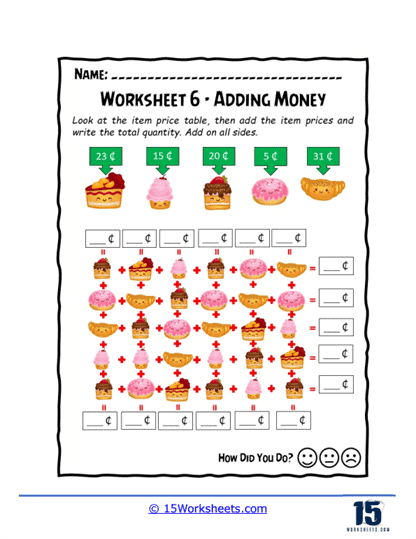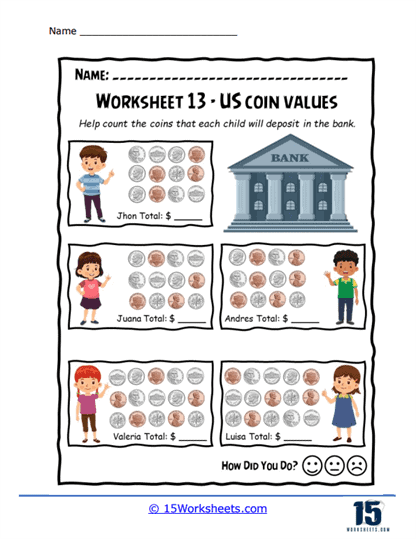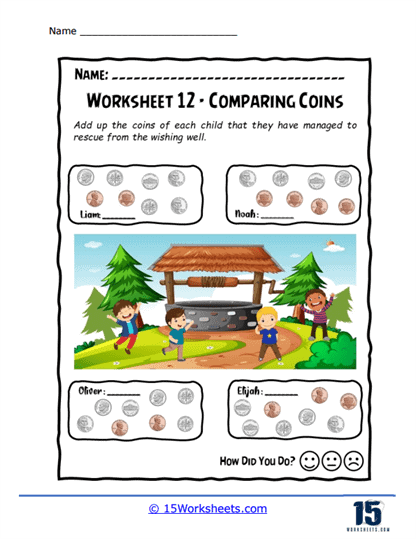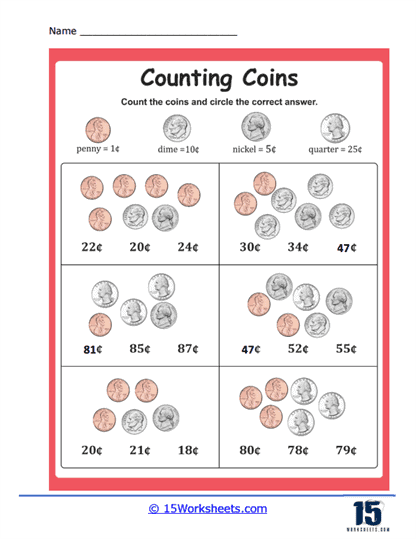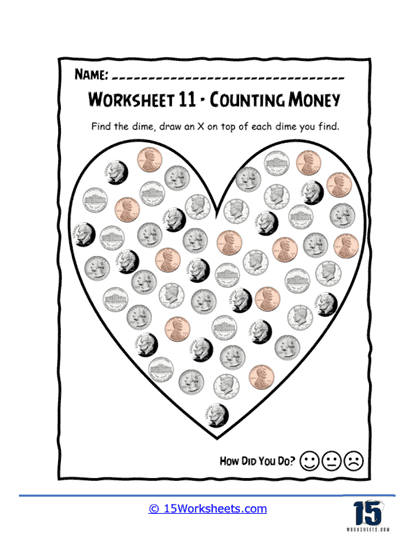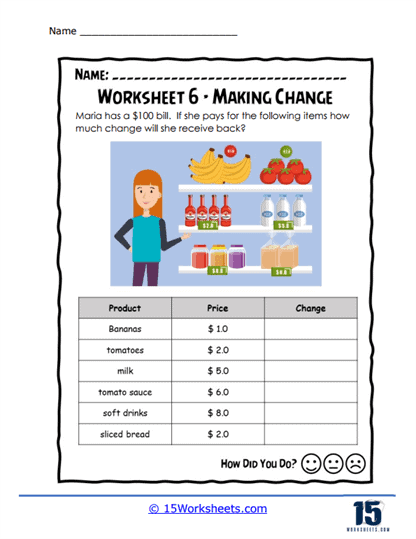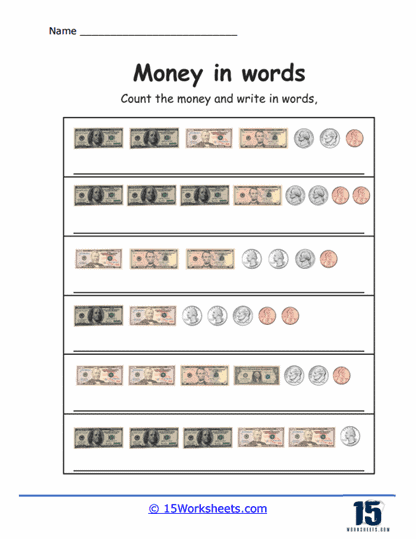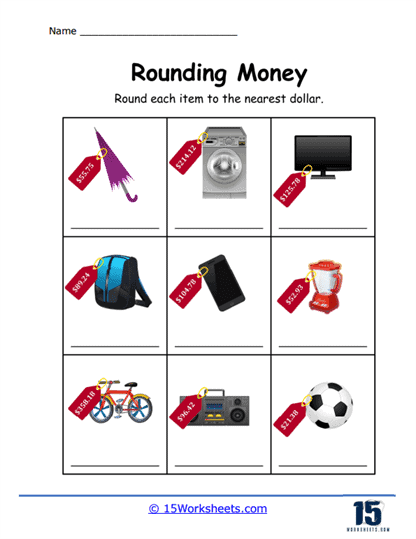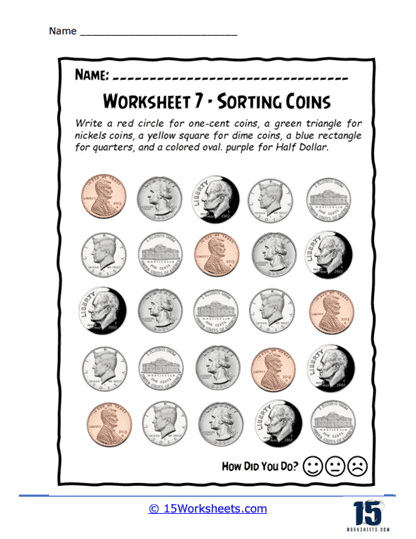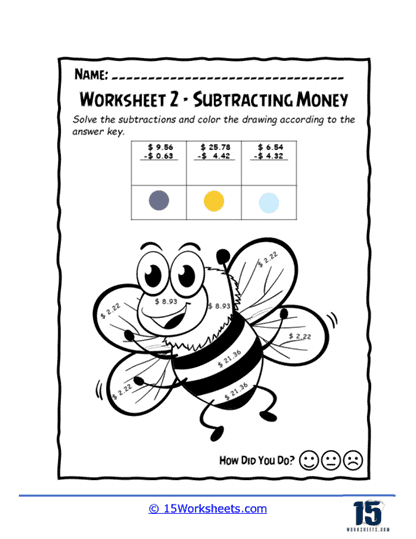Money Worksheets
About These Worksheets
These worksheets were designed to help students, typically in elementary and middle school, understand and manage money through practical and theoretical exercises. These worksheets cover various aspects of money management, including identification of coins and bills, counting and adding up money, making change, understanding savings and spending, and solving word problems related to financial transactions. By incorporating real-world scenarios, these worksheets aim to equip students with the necessary skills to navigate financial situations confidently and competently.
These worksheets include exercises on recognizing and understanding the value of pennies, nickels, dimes, quarters, half-dollars, and dollar bills. They progress to more complex tasks such as adding and subtracting amounts, comparing values, and making change. Advanced worksheets may introduce concepts like interest rates, budgeting, and basic principles of economics. The goal is to make students comfortable with handling money, understanding its value, and making informed decisions related to personal finance.
The ability to manage and understand money is a crucial life skill. It is essential not only for personal finance management but also in various professional contexts. Money math skills help individuals budget their expenses, save for future goals, and make informed spending decisions. In a broader sense, these skills are foundational for financial literacy, which is increasingly recognized as key to avoiding debt, understanding investment opportunities, and securing financial stability.
By engaging students with practical, real-world scenarios, these worksheets not only improve mathematical skills related to money but also prepare students for the financial realities of adult life. As students become more proficient in managing money through these exercises, they build a foundation for financial responsibility, critical thinking, and problem-solving skills that will serve them throughout their lives. The benefits of working with these worksheets extend beyond the classroom, improving students’ ability to function in the world by making informed financial decisions, understanding the value of savings and investment, and navigating the complexities of the economic landscape confidently.
A Look At The Worksheet Topics
These worksheets help students learn how to add different amounts of money, integrating both numerical addition skills and knowledge of currency values. They typically involve exercises where students must calculate the total amount of money represented by a combination of coins and bills.
This collection helps teach students about the individual values of coins in a particular currency system, helping them recognize and understand the worth of each coin. These worksheets often include activities like matching coins to their values, adding up coins to reach a certain amount, and identifying coins based on their characteristics.
This series can help students learn to compare the values of different coins, fostering skills in identifying which coins have higher or lower values than others. These worksheets may involve exercises where students sort coins, compare sets of coins to determine which has a greater value, or match equivalent values of different combinations of coins.
This selection of worksheets can teach students how to accurately count a combination of bills and coins, aiding in the development of their money management and math skills. These worksheets typically involve exercises that require students to calculate the total value of a set of various denominations of currency presented in a problem.
These are great for helping students learn to count and sum up the value of various coins, enhancing their understanding of currency and arithmetic. These worksheets usually feature exercises where students must identify and add together the values of different coins to find a total amount.
These can help you practice adding up the value of various denominations of money, including both coins and bills, to improve their mathematical and financial literacy skills. These worksheets often present a range of scenarios where students must calculate the total amount of money given in a mixture of currencies, fostering their ability to handle and manage money in real-life situations.
This collection will show you how to calculate the change due from transactions, a key skill for financial literacy. These worksheets typically present scenarios where a purchase amount is given along with the money paid, requiring students to determine the correct amount of change to be returned, using the smallest number of coins and bills.
This series can be used to help you practice writing and reading the numerical values of money in word form, enhancing their numerical literacy and understanding of currency. These worksheets often include activities where students must convert amounts of money from numbers to words and vice versa, reinforcing their ability to handle transactions and financial information accurately.
These 15 Worksheets are aimed at teaching students how to round money amounts to the nearest designated unit, such as the nearest dollar or cent, to simplify calculations and improve estimation skills. These worksheets typically include exercises that challenge students to apply rounding rules to various sums of money, enhancing their ability to make quick and efficient financial decisions.
These worksheets help students learn to categorize and organize different types of coins based on various attributes such as value, size, or country of origin. These worksheets often involve tasks where students must physically or visually sort coins into groups, aiding in the development of their recognition skills and understanding of currency differentiation.
These worksheets show you how to perform subtraction operations with different amounts of money, enhancing their arithmetic skills and financial literacy. These worksheets typically present scenarios where students need to calculate the difference between amounts of money, such as making purchases or comparing prices, to determine how much money is left or needed.
How These Worksheets Help Students
Real-world Application – By using practical examples, such as calculating change or planning a budget, worksheets help students apply math skills in real-life scenarios. This application of theoretical knowledge to practical situations enhances understanding and retention.
Incremental Learning – Worksheets are often structured to introduce concepts gradually, starting with basic identification and moving towards more complex financial calculations. This incremental approach helps students build confidence as they progress through different levels of difficulty.
Engagement and Interaction – Many worksheets are designed to be engaging, with colorful illustrations and interactive activities that make learning about money fun. This engagement encourages students to spend more time on task, leading to better learning outcomes.
Critical Thinking and Problem-Solving – Worksheets that include word problems and scenarios requiring budgeting or financial planning develop critical thinking and problem-solving skills. Students learn to analyze situations, consider various outcomes, and make decisions based on calculations.
Personal Financial Management – Through exercises that simulate real-life financial situations, students begin to understand the importance of budgeting, saving, and responsible spending. These early lessons lay the groundwork for healthy financial habits later in life.

